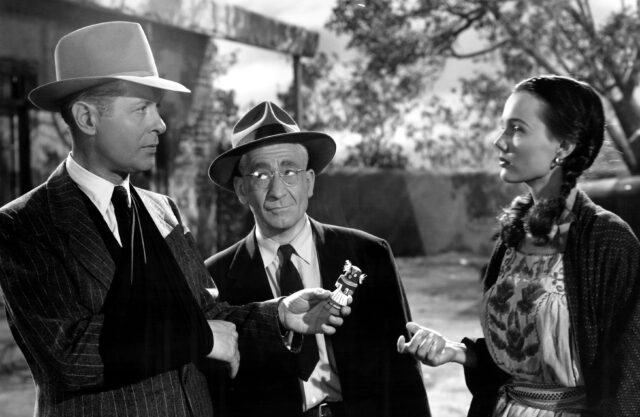Monday Movie: Ride the Pink Horse, by David Bax

Every Monday, we’ll highlight a piece of writing from our vaults. This review of Ride the Pink Horse originally ran as a home video review.
From the first moments, it’s clear that Robert Montgomery’s Ride the Pink Horse will not quite be the typical film noir. There are a few moments of disorientation when our protagonist, Lucky (played by Montgomery), steps off the bus and it’s unclear to us just where he is. The caucasian Lucky appears confident – if preoccupied – yet would seem to be out of place given that he is surrounded by people speaking Spanish. Just when you’ve started to decide that he is an American expat, the bus station signage comes into view and places us in a New Mexico border town. The setting would suggest Western more than noir and Montgomery borrows advantageously from the former genre. The resulting variety of character types and locations represents merely the surface layer of how fun Ride the Pink Horse is.
Upon his arrival, the first thing we see Lucky do is rent a bus station locker, place a slip of paper in it and then hide the key. Exactly what that piece of paper is will be revealed before long but we learn quickly that Lucky has come to town the weekend of a festival. So has Frank Hugo (Fred Clark), a vacationing crime boss who was the onetime employer and probable murderer of Lucky’s old war buddy. So Lucky has revenge on his mind and, on his way to finding it, befriends a gregarious carousel operator (Thomas Gomez) and an eccentric young woman (Wanda Hendrix) who will help him. His task is briefly complicated by the involvement of Hugo’s squeeze, Marjorie (Andrea King), who Ben Hecht and Charles Lederer’s screenplay drolly configures into noir’s most charmless would-be femme fatale.
These supporting characters are an indispensable part of what gives Ride the Pink Horse its color, despite the black and white cinematography. Clark’s villain is more harried than slimy and requires an electronic earpiece attached to a microphone that hangs from his lapel just to hear anything. Hendrix’s Pila, the young Mexican girl might be a little touched (in addition to carrying the burden of being played by a white woman). Art Smith shows up as an enigmatic lawman. And Gomez’s Pancho is both an unrepentant drunk and quite possibly the moral center of the movie.
Amidst all these characters is Lucky. Montgomery doesn’t just rely on the idiosyncratic locale to twist crime story tropes. He also, with sly intent, plays on our expectations of the story’s hero. In both screenplay and performance, we are allowed to believe that Lucky is the likable guy with a fatal flaw that comes standard with the noir genre. It’s not until we’re already on his side that Montgomery reveals that Lucky’s ambitions were less than noble from the start.
It’s this ability to keep the viewer guessing that gives Ride the Pink Horse the feeling of being unique or, at least, well ahead of its time. With its mixture of hardboiled grit and dirty neon surrealism, it could just as well be a postmodern neo-noir made decades later.






























